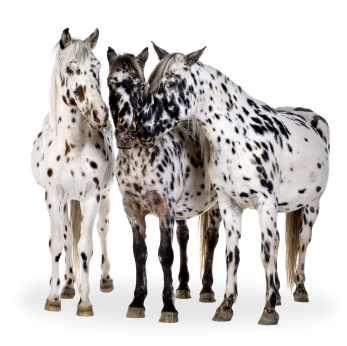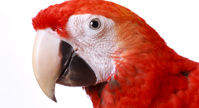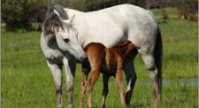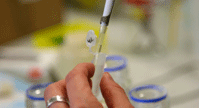Appaloosa Coat Pattern - Leopard Print and Congenital Stationary Night Blindness (CSNB)
Description:
 The coat patterns in spotted horses are genetically-related and are referred to as leopard spotting complex. The causal mutation associated with leopard complex are also linked to abnormalities in the eyes and vision (CSNB). These patterns are most closely identified with the Appaloosa horse breed, though its presence in breeds from Asia (Tiger Horses) to western Europe (Knabstrupper or Knabstrup) has indicated that it is due to a very ancient mutation. European cave paintings have recorded spotted horses indicating that the phenotype has existed for 20,000 years prior to their domestication, some 5,000 years ago.
The coat patterns in spotted horses are genetically-related and are referred to as leopard spotting complex. The causal mutation associated with leopard complex are also linked to abnormalities in the eyes and vision (CSNB). These patterns are most closely identified with the Appaloosa horse breed, though its presence in breeds from Asia (Tiger Horses) to western Europe (Knabstrupper or Knabstrup) has indicated that it is due to a very ancient mutation. European cave paintings have recorded spotted horses indicating that the phenotype has existed for 20,000 years prior to their domestication, some 5,000 years ago.
The Appaloosa horse descended from horses brought to American by the Spanish in the 16th century. The name Appaloosa comes from the Palouse river that ran through the Nez Percé Indians territory. The breed is best characterized by its spotted coat pattern commonly referred to as "leopard-complex". The leopard-spotted coat pattern has also been documented in several other horse breeds, including the Pony of the Americas, the Nez Percé Horse and several gaited horse breeds.
Within the Appaloosa breed there is a wide range of body types, stemming from the influence of multiple breeds of horses including Arabian blood lines which were introduced during the late 19th century. Although commonly recognized by their colorful coat patterns, Appaloosa horses have three additional identifiable characteristics including mottled skin around the nose, lips, and genitals, striped hooves and white sclera round the eyes.
In 2003, researchers linked the positional candidate gene for leopard complex (LP) to the TRPM1 gene on chromosome 1. Further investigations headed by Dr. Rebecca Bellone and The Appaloosa Project (a team of researchers from Canada and the US) identified several SNP's in TRPM1 showing complete association. Soon after that, the causal mutation was also discovered. Both the SNP's and the causal mutation can be used to develop a genetic test to identify horses with leopard complex.
ECA3P (PATN1)
A mutation SNP ECA3:23 658 447T>G in the RFWD3 gene is linked to an increased amount of white in LP horses known as Pattern 1 (PATN1). When combined with LP this mutation behaves in a dominant fashion. This means that a horse needs a single copy of the PATN1 mutation to observe large amounts of white as long as LP is present. Horse that are PATN1 positive but negative for LP will not have spotting but can pass of PATN1. A foal can receive a PATN1 copy from a solid non-spotted parent and a copy of LP from the other parent and be a few-spot or near few spot pattern.
Congenital Stationary Night Blindness (CSNB)
It has long been understood that a small percentage of Appaloosas are affected by both Equine Recurrent Uveitis and Congenital Stationary Night Blindness (CSNB), a condition making it difficult or even impossible to see in relatively low light.
Research has now shown that CSNB is a recessive disorder that is directly linked to the leopard complex in Appaloosa horses. DNA test for the LP mutations can also provide clear information as to CSNB.
Genetic testing of the leopard complex (LP) gene may be beneficial for several reasons. The first reason for testing is to confirm that an animal is a true Appaloosa horse. Another important reason is to identify those animals that are homozygous or LP/LP and could be affected by CSNB.
Test Results:
Animal Genetics offers DNA testing for the associated gene mutations for LP. The genetic test verifies the presence of the dominant LP Gene (designated LP) and presents results as one of the following:
| LP/LP | Homozygous | Positive for dominant LP gene. Indicates the animal carries two inherited copies. Homozygous LP horses are genetically bound to pass the gene to 100% of their progeny when bred, and all foals will be LP horses. Additionally, horses that test homozygous positive for LP will be affected by CSNB. Thus, appropriate measures must be taken to prevent possible harm to both the animal and its caregivers. |
| LP/lp | Heterozygous | Positive for dominant LP gene, carrying a single inherited copy. Heterozygous LP horses are statistically likely to pass the gene to 50% of their progeny when bred. |
| lp/lp | Negative | Non LP or spotted horse. |
Submit a Sample for Testing:
To submit a sample for testing please click on ORDER and download a sample submission form. Then follow the sample collection and submission instructions.
Cost per sample is $25.00. Please see our Equine Fee Schedule for all equine testing rates.










